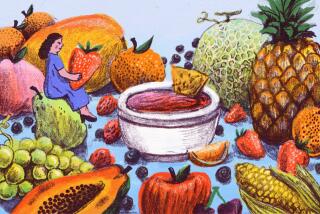When It Comes to Peppers, Some Like ‘em Hot : Chiles: Ranging from mild to red-hot, they are ingredients in many ethnic dishes. They also make attractive garden plants.
- Share via
Folklore has it that it was a brave person who ate the first chile pepper--but it was even a braver one who ate the second.
Peppers can be classified into two major, although not distinct categories--hot peppers and sweet peppers. Let’s limit our discussion to the hot peppers, the so-called chiles.
Chile pepper plants make an attractive and useful addition to the garden. The glossy-green plants with their upright plant habit and pretty, white blossoms complement most landscapes. They also make a beautiful container plant for patio or balcony.
Chiles can be utilized in many dishes and sauces, and their nutritional value is surprisingly high. Chiles are rich in vitamins A and C and are good sources of thiamine, niacin and riboflavin. Here is a rundown of some candidates for your garden.
By a wide margin, the jalapeno is the most popular chile; it is used extensively for pickling and hot sauces. In recent years, the jalapeno has been used in jellies, corn chips, canned beans and even lollipops.
The standard jalapeno is only medium-hot by chile standards. The plant produces huge quantities of 3-inch-long, tapered green fruit.
Too hot for your taste buds? A new, mild-flavored jalapeno has been developed. Called TAM Jalapeno, it is considerably milder than the standard jalapeno.
Another popular chile is the Anaheim chile, probably the mildest of the chiles. It gained fame as the “Ortega” chile. The Anaheim is used extensively in chile rellenos. The plant is larger than most chile varieties, and the green peppers are long and slender.
The Ancho is another mild chile. Its heart-shaped fruit is dried and utilized in Mexican red sauces.
The cayenne pepper is a 6-inch-long, red-hot chile. It is often dried in colorful strings and hung in the kitchen. The dried peppers are crumbled and used as a seasoning for various dishes. The plant is strikingly handsome when its fruit turns red. A new variety called Super Cayenne is a 1990 All-America Selections vegetable award winner.
The serrano chile requires a stomach of steel. It is a small (2 inches long) green pepper that is utilized in various Mexican and Asian dishes. These plants are different from other chiles in that the foliage has the texture of mint leaves.
What is the world’s hottest pepper? The habanero is. It’s 10 times hotter than a jalapeno and four times hotter than a tabasco. The pretty, lantern-shaped fruits are green, turning to gold when ripe. This pepper is incredibly hot--be careful when you are preparing or eating it.
Plants for many chiles (not the habanero) are available in local nurseries. Others have to be started in pots from seeds for later transplanting into the garden.
Peppers need lots of sun. They appreciate a well-cultivated soil that has been enriched with organic materials such as peat moss and compost. When preparing the soil, add a balanced vegetable fertilizer and water thoroughly.
Transplant pepper plants in the late afternoon. Space them 2 feet apart. Sprinkle them lightly at the time of transplanting, and repeat the sprinkling process daily for the first week. Once the plants are established, water weekly and feed them a light dressing of a vegetable fertilizer once a month. Always water after feeding.
Snails and slugs relish pepper plants, so be on the alert for them. Aphids are sometimes a problem, but you can control them easily by washing them off the plants with a garden hose.
Chile peppers grown in containers require more frequent watering and feeding.
Wear gloves when preparing the very hot chiles.
Seeds for the chile varieties mentioned here are sometimes available in local nurseries and garden centers. Seeds for all the varieties discussed here, including the torrid habanero, are available by mail order from Nichols Garden Nursery, 1190 N. Pacific Highway, Albany, Ore. 97321. They offer a free catalogue.
More to Read
Eat your way across L.A.
Get our weekly Tasting Notes newsletter for reviews, news and more.
You may occasionally receive promotional content from the Los Angeles Times.










